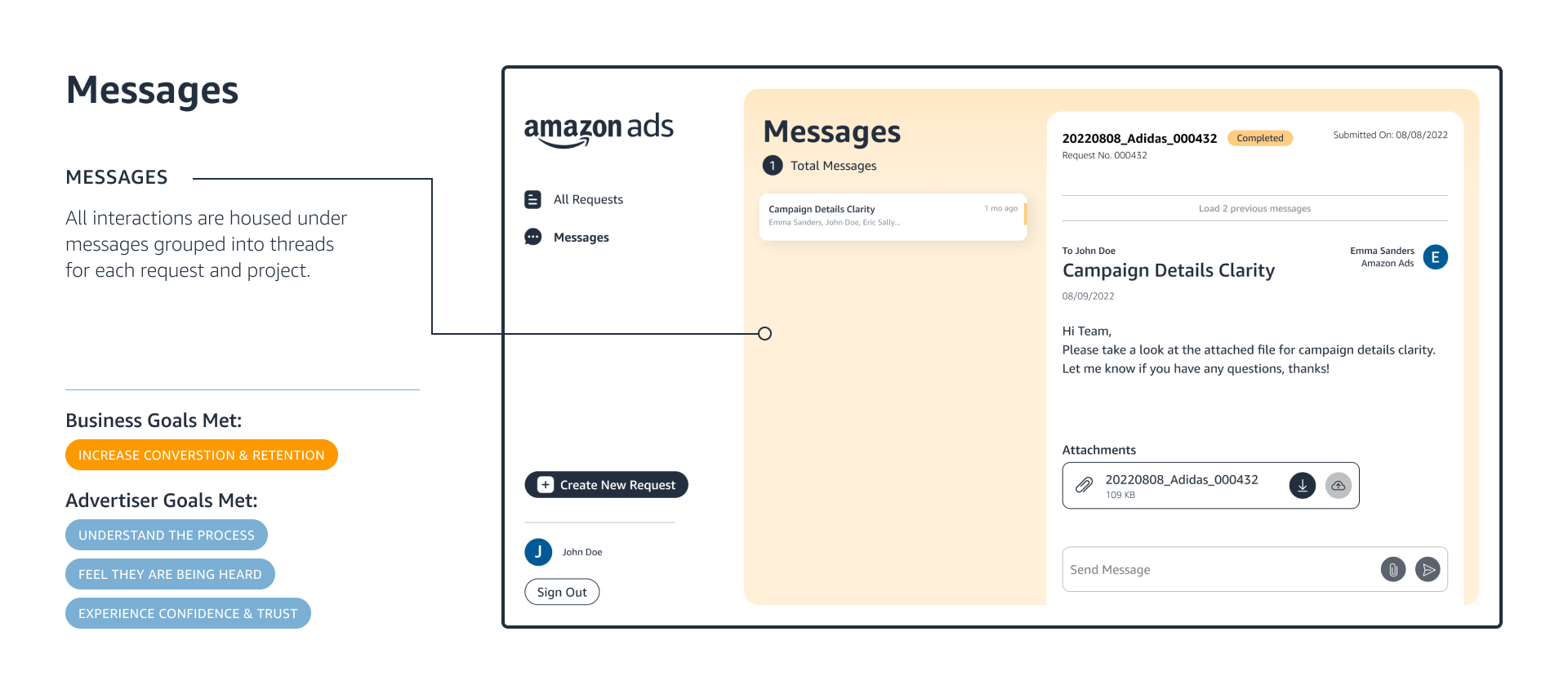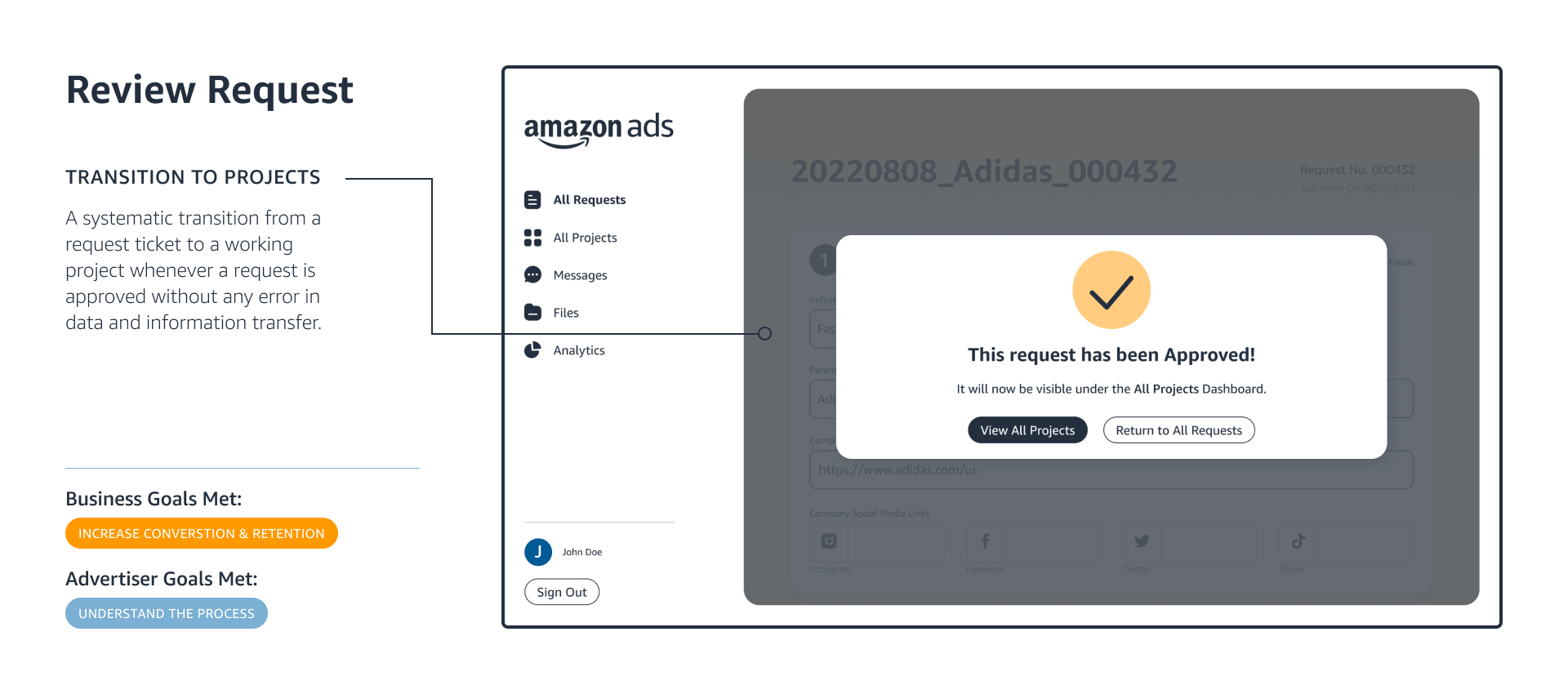
At the forefront of B2B ad buying, Amazon Ads harnesses the unparalleled reach and influence of Amazon's diverse ecosystem to empower businesses with unique online advertising solutions across multiple channels.
With a focus on operationalizing the Amazon Ads brand as a service, we developed a custom ticketing and project management tool that not only streamlines workflows but also strengthens the way advertisers collaborate withAmazon Ads.
I worked as the Interaction and Visual Designer in the team, supporting the Strategies in the research and strategy phase, and leading the wireframing, hi-fidelity design, prototyping in figma, ultimately delivering annoyed mockups to the front-end developer to create a working prototype.

We started by debriefing the brief, going deeper into Amazon Ads’ current workflow and understanding the advertisers goals and pain points in the landscape to extract and outline three key goals for the advertisers and Amazon Ads that ladder up to a complete engagement cycle.

The research gave way to the three key stages and pillars for any interaction between Amazon Ads and advertisers: Awareness, Consideration, and Conversation. Diving deeper into the audience and landscape, we identified what advertisers are looking for, and what the industry is currently offering, which helped us identify the white space for Amazon Ads.
Creating awareness by emphasizing the unique value of Amazon Ads
Advertisers have many options.
They visit various touchpoints—from other social channel business sites to market research services—to weigh their options before making a decision.
By focusing on search optimization, and highlighting the unique value propositions of Amazon Ads up-front, we get more people in the door—and then we make it immediately clear why they should choose Amazon Ads.

Demystify the consideration phase with clear & targeted information
Advertisers are afraid to get started.
Many small business owners don’t have marketing backgrounds, or any context about the process of creating an ad and how it works for their industry or business size.
Through personalized content, clear messaging, and interactive experiences, we help users understand what Amazon Ads can do for their business and how it works.

Facilitate conversation through integrated engagement opportunities
Advertisers want an intuitive and engaging partner.
While on the path to conversion, users need to find what they’re looking for as quickly and easily as possible through clear and intuitive navigational paradigms and a strong conversation model.
Enabling engagement opportunities that are educational, low effort, and fun for the user create seamless pathways to learn, and then look at Amazon Ads as their primary advertising partner.

We identified critical changes to the internal mindset and workflow to capitalize on the white space. We realized these changes in the form of key objectives that the new tool and product will work towards and address.

The process started with rough wireframe sketches to understand what the vision would mean in a tangible and practical product, figuring out the key components and features, main user flow.

This step involved exploration and testing to create an intuitive dashboard and tool, and visualize how the different features and functionality would connect and flow together seamlessly and create one unified user experience.

After solidifying the visual design and layout for key pages, we created a figma prototype to test out the functionality and flow between the pages and features on both the external and internal facing interfaces.

To bring the design to life in a working prototype, I created detailed annotated mockups listing all static and dynamic characteristics of each element and component to be handed to the front-end developer to be translated into code.

ABIL (Amazon’s Brand Innovation Lab) Dashboard is a custom ticketing and project management tool designed to streamline requests, track creative development of projects, and facilitate collaboration. From request intake to project delivery, every aspect of the process is seamlessly integrated into a single, intuitive platform—empowering stakeholders with control and visibility every step of the way.
Introducing ABIL Dashboard on the Amazon Ads website to create clear pathing for new and returning users to make a request.


ABIL Dashboard aims to streamline the flow of requests by establishing a ticketing system, tracking progress of the project at all stages, and prioritizing net new features to add value.






Taking the visual design and the annotations, the figma prototype was transformed into a coded working prototype.
These features add further functionality to transform the tool into a one-stop-shop for all request tracking and project workflow management needs.

We recommended defining success in terms of Key Performance Indicators (KPIs) and interpreting data in context.
These KPIs were derived from the higher level business goals, user goals, and measurement objectives.
